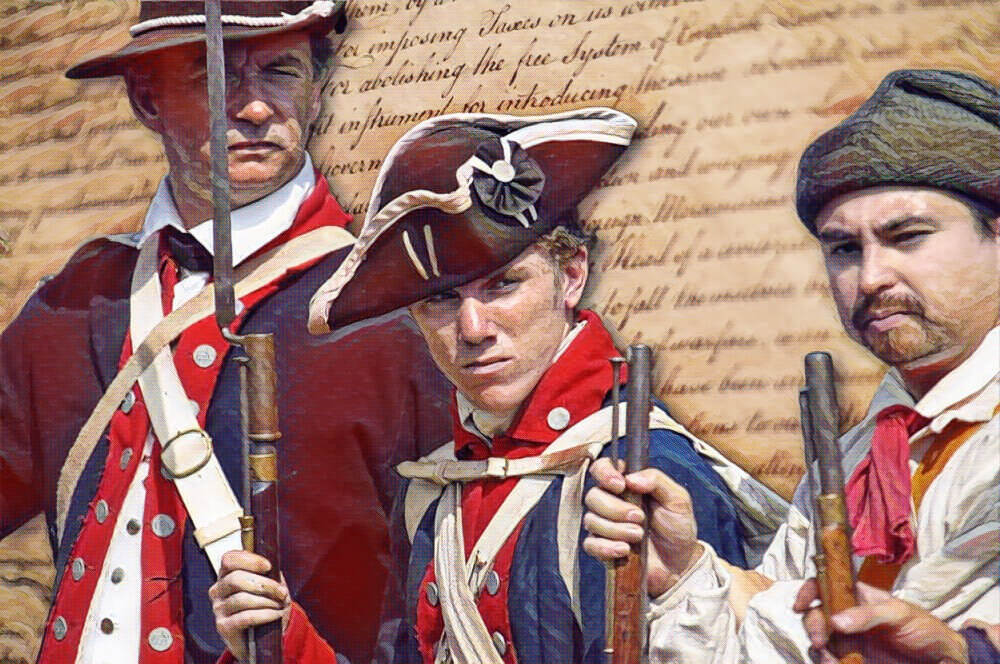
Declaration of Independence: Simfalex/Shutterstock; Continental Soldiers: n4 PhotoVideo/Shutterstock
By Richard Willis*
Copyright © 2023 – All Rights Reserved
Do not post or publish without written permission
Posted 3 July 2023
As the readers of this article are aware, the American Revolution (1775—1783) was an epic uprising resulting in the 13 British colonies securing political independence. Genealogists are often faced with the task of finding records of this formidable struggle in US history. As far as Britain is concerned the search for some very fruitful results can be seen or downloaded from the comfort of your home, library, or office.
TNA at Kew, London, UK, and military records
Many documents and other paperwork relating to this fascinating episode in the formation of the early states can be found online at the National Archives (UK) in Kew, housed in buildings that are just a stone’s throw away from the river Thames in London, England. Researchers can download a significant area of information ranging from the British War Office to the final period of Britain’s administration of America.
It is the Colonial Office files which include by far the most comprehensive evidence. Certain digital records at TNA can be viewed on the screen of your computer and can be retrieved indeed in almost any part of the world. As a bonus, at the time of writing this article, TNA does not charge for this service, though there are limits on the number of records that can be purchased at any one time.
As well as the above-mentioned files, there is also data available on the Admiralty and Treasury, the private papers of politicians and military officials, maps, and details of individuals who served with the British Army in America. Much of the documentation reflects the hardships that the empire faced in that phase of US history. The problems of the colonies, particularly from a British standpoint, provide detailed information underlining the role of officials such as governors who were at the centre of the empire. Alongside the mainstream of data, it’s possible to single out specific years in terms of their input into the wide range of documents available. For example, taking the year 1770, there are records dating back to the ‘Boston Massacre’, which involved the colonists, and the British troops.
Do note that much of the administrative personnel rarely were objective reporters and when they were their reports were often ignored by officials in London. I firmly believe that TNA can be a treasure trove and mine of information when it comes to gaining a wider appreciation of the revolution, not to forget the importance to the genealogist who is interested in piecing together fragments of detail in their hunt for family or military history.
The Discovery catalogue
So, how can the above-mentioned online files be retrieved and downloaded from TNA’s records?
The number of online files is growing significantly, but the task of securing a fully digital collection seems wishful thinking, and the existing body of records is far from complete. That being said, the first step to tracking down and downloading a record is to register online for a free account, and for this, you’ll need to provide an email address and password. Once you have clicked ‘register’ and confirmed your email address, you can access the catalogue termed as the ‘Discovery catalogue’. The Discovery page allows you to specify the search you are making, e.g., keywords and the range of years you want your investigation to cover.
For files that you can print off, you would have to confine the search to TNA records only. And remember not all documents can be downloaded.
The remaining instructions are self-explanatory. To give an example, let’s go back to the Discovery page and search for the ‘American Declaration of Independence’ within the years 1775 to 1778; we also want records held by the National Archives only. The next step is to click on search. Make sure you are signed in and follow the instructions to download the document. The site allows you to print off a maximum of 100 items over 30 days.
A search service & visiting in-person TNA
The TNA allows readers access to records on the American Revolution which otherwise may only be seen by travelling in excess of 3,500 miles to London, with the accompanying cost and upheaval caused by such a long journey. Where essential research is to be carried out, TNA also provides a search service, but it is costly, yet still financially viable in terms of the expense of a personal visit to Kew. After you have made your request, a researcher at TNA will be able to give you a quote on how much the search will cost.
Further information about hiring a researcher can be found at:
https://www.nationalarchives.gov.uk/help-with-your-research/paying-for-research/our-paid-search-service/
If you find yourself on holiday in London, it is worth spending a day visiting TNA. The nearest station is Kew Gardens, which is on the District line of the London Underground, and TNA is within each walking distance once you have arrived by train.
The abiding interest in any research at Kew is supported by the fact that certain documents can now be downloaded, coupled with a search service. Even where a record has not yet been digitized, the use of Discovery can often give a good understanding of where specific information on the American Revolution is stored.
Failing to find locate the exact reference, the search service within TNA is available. A determined effort to extract what you are looking for can lead to positive results, which can be both helpful and rewarding.
*Richard Willis is a visiting research professor at the University of Sussex and a visiting professor at the University of South Wales.
